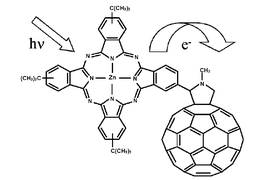Long-lived photoinduced charge separation for solar cell applications in phthalocyanine–fulleropyrrolidine dyad thin films†
Abstract
The photophysical properties of a new dyad molecule composed of a covalently linked Zn-phthalocyanine (antenna/donor) and a C60 derivative (acceptor) have been investigated. We report experimental evidence of long-lived charge separation in the solid state with a lifetime several orders of magnitude higher than in solution. Such a long lifetime, unusual for


 Please wait while we load your content...
Please wait while we load your content...